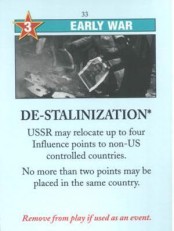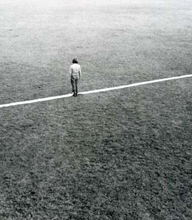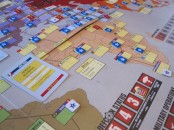It is curious that chance and all the chaos it implies became a bedrock component of what it is to be American. From a young age, schoolchildren are told that they can become the president or an astronaut, because only in America do people have the chance to become whatever they want. The market system carries the belief that only chance can guarantee true transactional efficiency and separate innovative wheat from mundane chaff. Interventions that impede working of the “invisible hand” increasingly crowd out the chance new discoveries will be made. Narratives using chance in American culture — the rags-to-riches story, or immigrant emigration story lines — are so prominent, they are often taken for granted. But the illusion of freedom these narratives convey helps conceal the way chance circumscribes experience. Even the phrase land of opportunity carries overtones of chance: Some will make it; others won't. There is no destiny, only opportunities that one must take advantage of when chance allows.
Chance’s prominence in the zeitgeist reached an apogee during the Cold War, when threat of nuclear annihilation reshaped not only the physical landscape (rusted signs on schools denoting Fallout Shelters come to mind) but also the emotional one. Ideological interpretations of chance came to the fore as the Americans and Soviets battled for hearts and minds. Marxist doctrine, with its “scientific” approach to history, could proudly proclaim that there are "No accidents, Comrade," while American counterparts charged that hubris-laden Soviet prognostication only masked totalitarianism. Objective reality, or the belief that one's worldview and ideology are markers separating verified, truthful observations from false, misleading illusions, for Americans hinged on chance, whereas for the Soviets it hinged on chance’s elimination.
U.S. Cold Warriors asserted that chance distinguishes truth from illusion "precisely because it is not subject to human planning and lies outside of design," as Steven Belletto notes in No Accident, Comrade: Chance and Design in Cold War American Narratives. The Soviets’ quasi-Marxist analysis of history ran squarely against American belief in the volatility and uncertainty of human action. American ideologists argued that only totalitarian control could provide such certainty. You can't plan human innovation or introduction of new ideas, they would say, you can only let chance take hold and put your faith in the true arbiter of reality: chaotic potentiality.
However, the American belief in the benevolence of chance runs squarely against fiction’s narrative design and the “totalitarianism” of a fixed plot — an awkward contradiction that some American authors of the period (Robert Coover, Thomas Pynchon) pursued in their work. Belletto notes “that chance is at odds with the ordered nature of narrative design” and makes a convincing case that during the Cold War, chance took on a new aesthetic (no, not that new aesthetic), with lingering effects. He argues that the antagonism the authors revealed help make chance so complexly elastic that it became useless for distinguishing between U.S. and Soviet attitudes. By framing narrative design around conflicts brought about by chance (plots involving dice rolls, card play, or accidents), authors of the period demonstrated that American beliefs about the righteousness of chance possessed serious faults. Race relations, notions of democratic freedom, and justifications for the increasing marketization of human affairs are all obscured or concealed to some degree by cultural narratives that embrace chance as panacea to any ills these beliefs contain.
The fiction writers of the period were able to show the ideological culpability of chance in the Cold War era, but what happens to chance’s experiential meaning when deployed in a game about the Cold War? Just as Belletto regards chance as a “prism” that unlocks a new aesthetic for reading fiction, I see a similar possibility with the board game Twilight Struggle, first released in 2006. Revered by enthusiasts but little known outside of war-gaming circles, Twilight Struggle intertwines narrative construction and chance to create a two-to-four hour simulation of the entire Cold War. The game plays with ideas of chance in much same way as the fiction Belletto focuses on.
But where fiction generally resists reader alteration, board games take it for granted and depend on it. A fictional narrative remains the same despite how it’s interpreted by readers. The underlying expectation in gameplay, however, is that the player actively constructs a narrative and perhaps even modifies the game’s rules. Meaning for players comes only through the active process of experiencing play. Operating Twilight Struggle's narrative platform provides a ludic truth — truth through play that gives experiential knowledge using popular, though misleading, historical explanations for the period. It purports to compress the Cold War experience while maintaining some semblance of fidelity to the mentalité of the period, but the chance experienced through gameplay is wed to narrative exposition that clearly embraces a U.S.-centric worldview. Chance narratives help players validate experiential knowledge they acquire during play, but their execution actually inverts the meaning of chance, so that the objective reality behind the Cold War presented in Twilight Struggle becomes illusion. The ideology behind chance is thus recharged through play, validating the American Cold War experience on the basis of an illusionary reality where chance effects are safely circumscribed.
While summary works of Cold War history can run to hundreds of pages, Twilight Struggle’s rule book provides all the physics and intricacies to construct your own in just 10. The rules set the boundaries of possibility, the sum of chance occurrences that will demarcate the objective reality of the game as it retells the historical narrative. But the story the game tells varies not merely in terms of the chance occurrences that the rules stipulate, but, more important, in the nostalgia it evokes. Players can see how gameplay affects the way the alternate history unfolds, but it is nostalgia that makes the game’s themes emotionally tangible. This distorts the experiential knowledge of the Cold War produced through play. By invoking Cold War nostalgia and collective memories of the historical experience and blurring it with the alternative narrative the game supposedly enables, Twilight Struggle clearly embraces an Amercian-centric worldview of how the Cold War developed.
Nothing embodies this more than the 110 event cards, the primary factor guiding narrative assemblage. Few of the game’s event cards register Soviet advancements or achievements in a positive light, and social events are abstracted to such a degree that the two superpowers resemble monolithic hegemons locked in a battle with zero consequences for their own internal populations. The embodiment of chance, the cards are shuffled and dealt anew at the start of each turn. But the three separate decks, which correspond to three broadly defined eras of the Cold War, are rich-media artifacts in their own right, containing images, game text, and symbology tied to the “alignment” of the event in question. The Marshall Plan, NATO, Vietnam Revolts, and the Arab-Israeli War, just to name a few, all make an appearance in the event decks.
When players look at their cards, they are interpreting several levels of meaning. They summon nostalgia about the event or personality depicted on the card while simultaneously integrating the cards into larger gameplay narrative. “De-Stalinization,” for example, is a Soviet event,
 De-Stalinization
De-StalinizationThe gameplay itself also deliberately evokes a distorting nostalgia, sympathetically integrating the Cold War logic of game theory and containment. Twilight Struggle’s card mechanics mimic the game-theory analyses that ruled the early Cold War, cleverly integrating game-theoretical decision making within the game’s unfolding narrative. Though historians have debunked game-theory narratives, tension-filled bluffing forces each side to run “min-max” scenarios with regard to gameplay. Should one play their weakest cards first, luring the enemy into a false sense of security? What are the odds of the opponent holding that one killer card that could destabilize one’s victory plans?
Twilight Struggle brings home Cold War game theory’s “rational irrationality” (think of the doctrine of mutually assured destruction, “first strike” military scenarios, or even the movie Dr. Strangelove) by including a DEFCON meter — a numeric scale used by the U.S. military to indicate alert-readiness posture (five equals peace; one equals nuclear war). Because of the rules governing coups in Twilight Struggle, it’s a viable strategy for the Soviet player is to drive DEFCON to level two to prohibit the U.S. player from gaining footholds in potentially valuable scoring regions. By extension, it becomes perfectly logical to drive the narrative in Twilight Struggle as close to nuclear war as possible, which paradoxically allows players to more carefully manage the chances of nuclear war actually occurring. “Rational irrationality” embodied in the design thus transforms into “irrational rationality” through play, creating an objective reality of security for the player where in reality there existed only the illusion of security. (See also: Cuban Missile Crisis) By embedding this possibility in the game’s mechanics, Twilight Struggle channels memories of Cold War tension into an explanatory model about why the Cold War unfolded as it did but in ways that obscures the madness those tensions produced.
Twilight Struggle also models containment, the logic of which is encapsulated in U.S. ambassador to the Soviet Union, George Kennan’s famous Long Telegram to the Treasury Department in 1946 describing Soviet leaders as "impervious to logic of reason, and…highly sensitive to logic of force." The Soviet player has no alternatives other than brute force to win the game. You cannot “negotiate” with the U.S. player precisely because the victory conditions are tied to an ideologically framed hegemonic struggle. Twilight Struggle’s game board depicts countries as blank dominoes ready to become receptacles of superpower influence, just as U.S. Cold War geopolitical orthodoxy conceived it. Nations around the globe are little more than pawns in the larger game of ideological persuasion. The rules allow players to place “influence” in countries adjacent to those they already influence, producing a visual demonstration of the domino effect in action. This inscribes the promise and peril of containment policy: It can be a heady feeling to look at the board after a long game and see the sprawling network of blue or red trace around the world.
The finished network of global hegemony that a game of Twilight Struggle yields is impressive, but what is the cost of this network? What did it cost in the real Cold War? While some mechanics or card events are overtly militaristic, the game’s focus on the placement of influence leaves the specific nature of that influence abstract. In Twilight Struggle there can be no detente or “peace without victory” as the game lumbers into the Cold War’s final years. Even if the Soviet player manages to accrue 20 victory points and win, the rules structure the game’s time frame around historical reality, ending in 1989 "when only the United States remained standing." As the Soviet player, you cannot win for losing.
Given Twilight Struggle’s U.S. bias, players have been quick to develop alternate game boards and alternate event card sets, some in foreign languages. At Board Game Geek, a user created alternative-event card titled ‘72 Series Summit, about a hockey series between Canada and the USSR. The card features the iconic photo of winger Paul Henderson celebrating after scoring the winning goal. In pure game terms the '72 Summit Series card has little value, but in terms of narrative construction and ludic truth, however, it affirms Canadian influence in the larger Cold War narrative. Whereas Twilight Struggle relegates Canada to a mere support role, the '72 Summit Series card creates narrative-generative effects for Canadian culture in the otherwise exclusionary design model.
One might protest that Twilight Struggle is just a game and it’s unfair to hold it to standards beyond its intended purpose of entertaining players. But the way it produces experiential knowledge has broader implications for how chance narratives imbedded in the design reflect the way objective reality is demarcated from illusion. As Twilight Struggle makes clear, chance narratives justify totalitarian control of the country and nuclear brinksmanship all in the name of scoring an ideological victory. Chance becomes something whose effects can be calculated and which can be made to serve a distinctly nonrandom ideological purpose. Players become instruments of totalitarianism endowed with righteous purpose, the narrative of chance employed to suit a uniquely American perspective in a manner that subverts the implications of chance utilized in defining American freedom. Objective reality inverts through play and the zero-chance Soviets become mirror reflections of ourselves.

